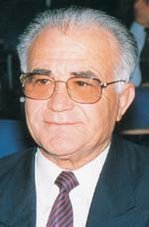Ελίκη - from Wikipedia.org.wiki. Helike
This article is about the ancient Greek city. For the mythological nymh, see Helike (mythology). For the moon of Jupiter, see Helike (moon).
Helike (Greek: ‛Ελίκη pron. IPA /he.ˈli.kɛː/ or /ɛ.ˈʎi.ci/; see also List of traditional Greek place names) was an ancient Greek city that sank in the winter of 373 BC at night. The city was located in Achaea, Northern Peloponnesos, two kilometres (12 stadia) from the Corinthian Gulf (coordinates: 38°13'09"N, 22°07'58"E).
Helike was founded in the Bronze Age, becoming the principal city of Achaea. Helike led the twelve cities of the first Achaean League, and founded colonies, including Priene in Asia Minor and Sybaris in South Italy. Its pan-Hellenic temple and sanctuary of Helikonian Poseidon was known through the Classical world.
The city was destroyed in 373 BC, two years before the Battle of Leuctra.
The event happened on a winter night. Several events warned of the disaster. Some "immense columns of flame" appeared, and five days previous, all animals and vermin fled the city, going toward Keryneia.
The city and a space of 12 stadia below it sank into the earth, and were covered over by the sea. All the inhabitants perished, and not a trace remained, except for a few fragments projecting from the sea. Ten Spartan ships anchored in the harbour were dragged down with it. An attempt involving 2000 men to recover bodies was unsuccessful. Its territory was taken possession of by the Aegium.
The catastrophe was attributed to the vengeance of Poseidon, whose wrath was excited because the inhabitants of Helike had refused to give their statue of Poseidon to the Ionian colonists in Asia, or even to supply them with a model. According to some authorities, the inhabitants of Helike and Bura had even murdered the Ionian deputies.About 150 years after the disaster, the philosopher Eratosthenes visited the site and reported that a standing bronze statue of Poseidon was submerged in a "poros", "holding in one hand a hippocamp", where it posed a hazard to those who fished with nets.
Around 174 AD, the traveler Pausanias visited a coastal site still called Helike, located 7 km southeast of Aigion, and reported that the walls of the ancient city were still visible under water, "but not so plainly now as they were once, because they are corroded by the salt water".
For centuries after, its submerged ruins could still be seen. Roman tourists frequentaly sailed over the site, admiring the city's statuary. Later the site silted over and the location was lost. A Roman city was built on the site.
Scholars who visited the ruins:
- The Greek geographer Strabo
- The Greek traveler Pausanias
- The Greek historian Diodoros of Sicily
- The Roman writer Aelian
- The Roman poet Ovid.
Rediscovery
The Greek archeologist Dora Katsonopoulou rediscovered the city in 2001, buried in an ancient lagoon. Another city found nearby, dating from the Bronze Age (around 2400 BC) shared the same fate as Helike, just two millennia earlier.

2 comments:
You have really great taste on catch article titles, even when you are not interested in this topic you push to read it
Very shorts, simple and easy to understand, bet some more comments from your side would be great
Post a Comment